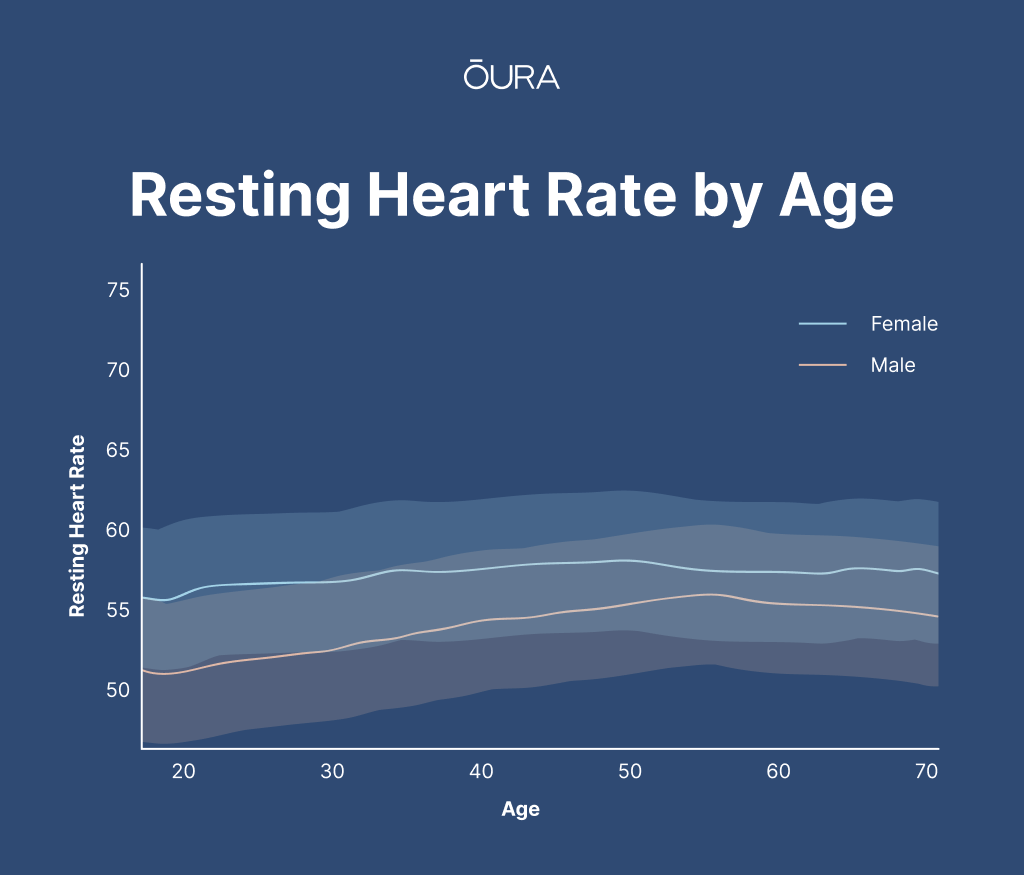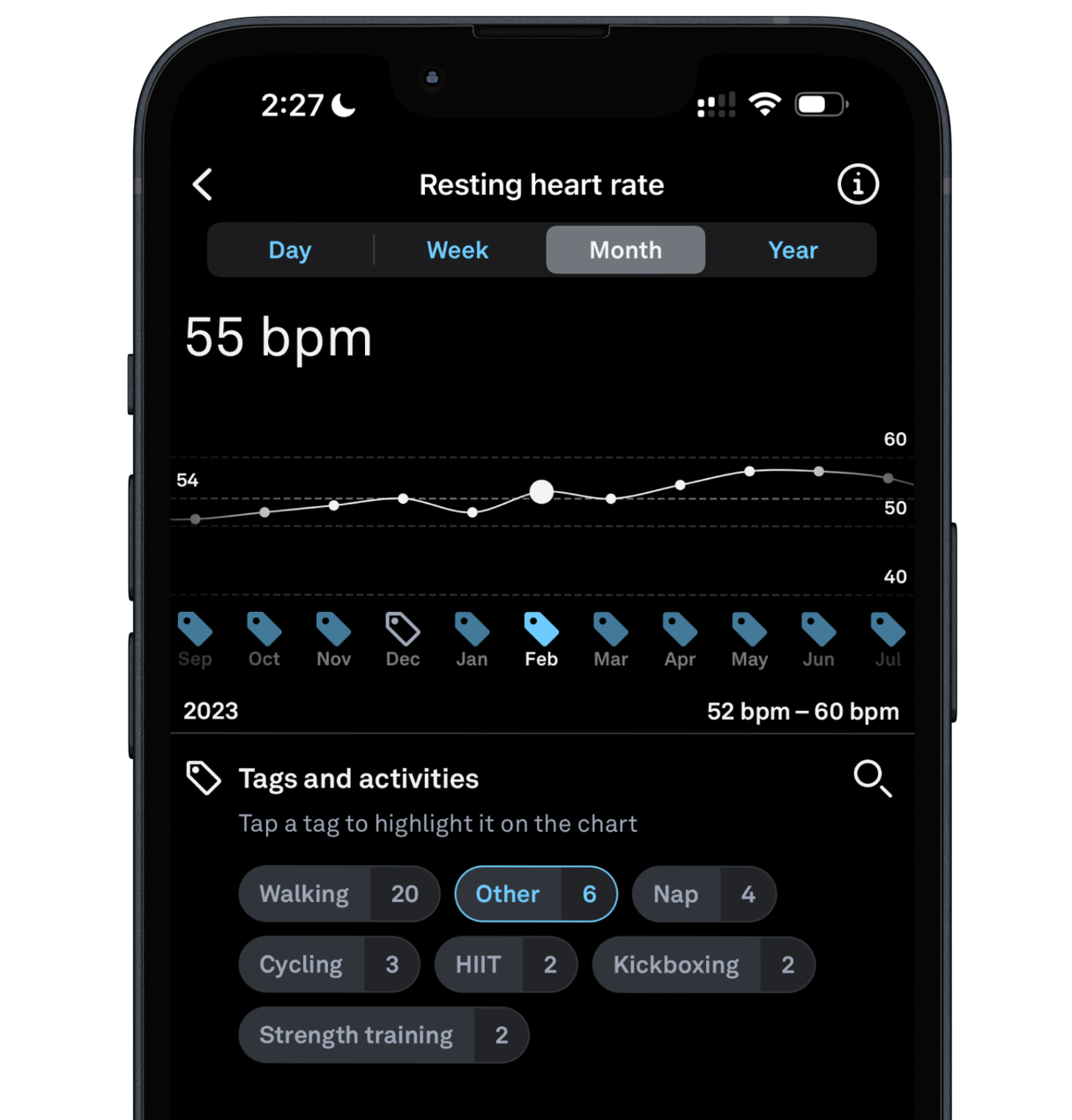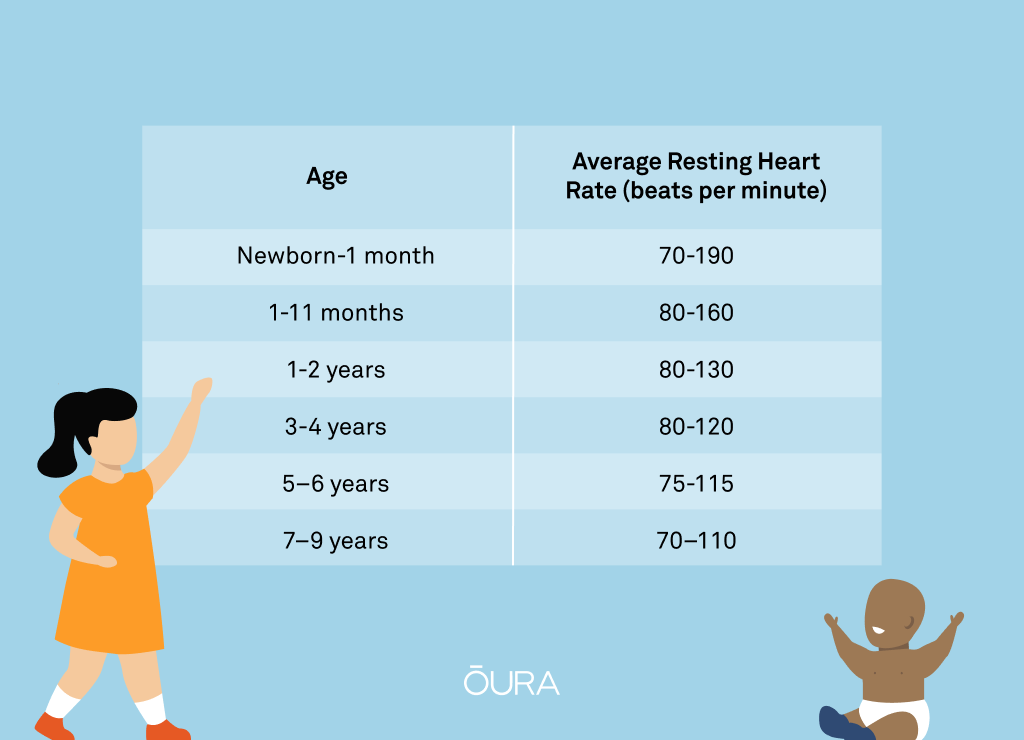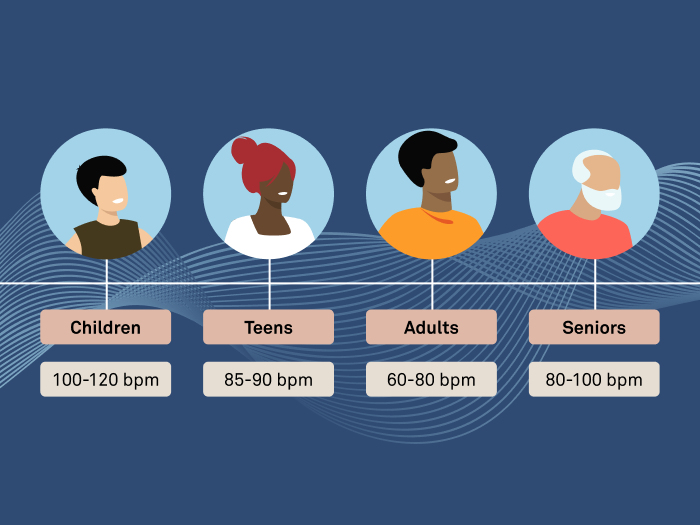- The normal sleeping heart rate for an adult falls between 60 to 100 beats per minute, but it varies throughout your life. If you’re wondering what is a normal sleeping heart rate by age, the answer depends on various factors like metabolism and heart strength.
- Oura members can track their heart rate by looking at their resting heart rate in the Trends view.
- Certain factors can help lower a high resting heart rate, such as prioritizing restful sleep, quitting smoking, reducing alcohol and caffeine intake, losing weight, and managing stress.
Imagine you’re in a state of perfect relaxation, asleep after a long day at work. Your heart is still hard at work, but it’s not racing — it’s in a state of rest.
This is your resting heart rate (RHR), often referred to as the sleeping heart rate. Your RHR is the number of times your heart beats per minute when you are at complete rest, typically during sleep or periods of inactivity.
In general, RHR falls within the range of 60 to 100 beats per minute (bpm). Among adult Oura members, an analysis found that resting heart rates range from mid-50s to mid-60s bpm. As you can see in the chart below, Oura members’ RHR also increases slightly until about age 60, at which point it levels off and lowers slightly.

Your sleeping heart rate varies by age because your body undergoes various changes in oxygen requirements and heart strength throughout your life. What is a normal sleeping heart rate by age? It typically follows predictable trends, decreasing as we grow older. Tracking these changes can help you to distinguish normal age-related variations from potential health concerns.
RELATED: Sleeping Heart Rate: Look for These 4 Patterns
Tracking Your RHR With Oura: What Does Oura Ring Track?
Using Oura, you can see how your RHR changes over time. Using the Oura Trends view, you can see how your RHR changes over the course of week, month, and year. This can give you an insight into how your body is responding to your daily habits, and you’ll be able to observe any significant changes that may be an indication of a condition that needs addressing.

If you’re an Oura member, open the Oura App to track your heart rate with the Live Heart Rate Graph. You’ll find color-coded visuals displaying your daytime, sleeping, and workout heart rates, along with Restorative Time periods.
| Member Tip: Gain further insights into your overall heart health by using Oura’s new heart health features: Cardio Capacity and Cardiovascular Age. |
How Accurate is Oura Ring?
Your Oura Ring can track your heart rate. But how accurate is it? Good news: external validation studies have found “very high agreement” between the Oura Ring and the gold-standard ECG measurement. The Oura Ring performed near-perfect for resting heart rate (r² = 0.996) and extremely high for heart rate variability (r² = 0.980) when compared to a medical-grade ECG device.
LEARN MORE: How Accurate Are Oura’s Heart Rate & HRV Measurements?
Babies and Children: What is the Normal Sleeping Heart Rate?

Infants and toddlers generally have a higher resting heart rate compared to adults — their hearts beat faster, often between 70 to 190 bpm. If you’re asking, what is a normal sleeping heart rate by age, it varies significantly between infants, children, and adults. Several physiological and developmental factors contribute to this variance, including:
- Smaller hearts: Infants and toddlers have small hearts, which must work harder to meet the demands of a growing body.
- Higher metabolic rate: Infants and toddlers have a higher metabolic rate than adults, resulting in higher oxygen consumption, as well as higher heart and respiratory rates.
- Developing autonomic nervous system: The autonomic nervous system is responsible for regulating involuntary functions, such as heartbeat. Infants and toddlers are still developing their autonomic nervous system, which can lead to an increased heart rate.
- Sensitivity to external stimuli: Infants and toddlers are more sensitive to external stimuli than adults. This can cause their heart rate to increase in response to changes in temperature, sights, sounds, and being picked up frequently.
The typical heart rate range between birth and six years is around 70 to 190 bpm. At ages seven to nine, just before children enter the adolescence stage, the resting heart rate usually falls between 70 and 110 bpm. However, it’s important to note that these are average values, and individual heart rates can vary based on various factors, including overall health and genetics.
While a higher RHR is normal in this age group, extreme variations or persistent changes should be discussed with a pediatrician to rule out any underlying medical conditions.
Adolescence to Adulthood: Normal Sleeping Heart Rate

As children enter the teenage years, their RHR stabilizes and gradually decreases to a steady, healthy state. What is a normal sleeping heart rate by age? For teenagers, a range of 60-100 bpm is considered typical. While specific data on the speed of this stabilization is limited, it’s generally observed that people reach a stable RHR of 60-100 bpm during their teenage years and early adulthood. Well-trained athletes may even have RHR as low as 40-60 bpm, indicating a healthy heart.
In general, a lower resting heart rate typically signifies a healthier heart muscle that doesn’t need to exert excessive effort to maintain a consistent rhythm. Research has uncovered a connection between a higher resting heart rate and factors such as lower physical fitness, obesity, high blood pressure, and an increased risk of hypertension and heart disease.
READ MORE: 8 Possible Reasons Why Your Resting Heart Rate Is High
What if Your RHR Is Lower or Higher Than Usual?
Day-to-day fluctuations in RHR are to be expected. Bradycardia or tachycardia are conditions characterized by persistent low or high heart rate beyond the normal range.
Bradycardia refers to a slow heart rate. In most cases, a resting heart rate below 60 bpm is considered bradycardia. However, some athletes and people with high activity levels may have lower resting heart rates without any problems.
On the other hand, a heart rate above 100 is considered tachycardia, and it can be caused by several factors, including anxiety, strenuous exercise, fever, pain, and certain medications. Less common causes of tachycardia include health conditions such as anemia, very low blood pressure, infection, cardiovascular disease, and sleep apnea.
A sharp increase in your RHR could also indicate atrial fibrillation (A-Fib). This common heart condition affects up to 6 million Americans at any given time, and can be life-threatening. It causes an irregular, rapid heart beat, and can come on suddenly.
| Member Story: Using Oura data, member Dave K. noticed a sudden increase in his RHR, from 49 bpm to 140 bpm. This prompted a visit to his doctor, where he was diagnosed with A-Fib. |
How To Support a Healthy Sleeping Heart Rate
If you notice a consistently high resting heart rate, there are some steps you can take to mitigate this, outside of consulting a medical professional.
Get Plenty Of Sleep
When you don’t get enough sleep, your body doesn’t have time to rest and repair itself. This can lead to stress on the cardiovascular system and a faster heart rate. To lower your resting heart rate, prioritize restful, deep sleep and get enough sleep in all the sleep stages. In the Oura App, you can use your Sleep Score to monitor and improve your sleep quality.
Quit Cigarettes and Cut Back on Alcohol
Both smoking and excessive alcohol consumption have adverse effects on your resting heart rate (RHR). Smoking, with its nicotine and chemicals, elevates heart rate and strains blood vessels, making your heart work harder.
Similarly, alcohol consumption boosts stress hormones like cortisol, leading to a higher RHR. It also disrupts sleep, further affecting your resting heart rate.
| Member Tip: Oura members can use the Tags feature to monitor how alcohol impacts their sleep quality, making it easier to make lifestyle changes and pursue a healthier path. |
RELATED: How Alcohol Impacts Your Sleep
Reduce Caffeine Intake
Caffeine is a natural stimulant that can cause the heart to beat faster. Furthermore, high caffeine intake may negatively impact your sleep, which may increase your RHR in turn. So, it’s best to limit caffeine or look for alternatives that your heart will love.
Lose Weight
Excess body weight requires the heart to work harder to supply blood to all tissues, leading to an elevated resting pulse. Weight loss through diet and exercise can significantly lower RHR. As excess weight is shed, the heart experiences less strain, allowing it to function more efficiently at rest.
| Member Story: For Tricia S., tracking Oura data like heart rate was pivotal in her 75-pound weight loss journey. “When my resting heart rate (RHR) started to come down, I knew that it was a sign that my body was responding well — without even needing to look at the scale.” Using the Trends view on the Oura App, Tricia saw that the small changes she made in her life added up over a year, making her much healthier. |
Manage Stress
Stress hormones, like adrenaline and cortisol, can stimulate the heart and increase resting heart rate. Techniques such as meditation, yoga, or breathing exercises can reduce stress and, subsequently, lower RHR. These practices promote relaxation, reduce the heart’s workload, and contribute to a healthier resting rate.
| Member Tip: Oura members can tap Explore content on the Oura App to access a wide range of meditation content. You’ll receive immediate biofeedback after each session to help you see how well your body is responding to the meditation. |
READ MORE: 9 Simple (and Science-Backed!) Ways to Lower Stress
When To See a Doctor About Your Resting Heart Rate
While following the steps mentioned earlier can help lower your resting heart rate, there are times when it’s essential to consult healthcare professionals. The American Heart Association lists symptoms that could be linked to both bradycardia and tachycardia, including:
- Chest pain
- Confusion or memory problems
- Dizziness or lightheadedness
- Easily tiring during physical activity
- Fatigue
- Fainting (syncope) or near-fainting
- Shortness of breath
If you experience any of these symptoms, schedule a visit to the doctor.




